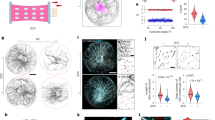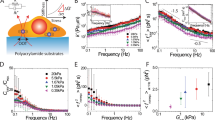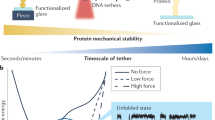Abstract
Mechanical forces play indispensable roles in biological processes in living organisms. Cells in living organisms sense and process mechanical information that is critical to their growth, motility, and other physiological functions. The cytoskeleton has a significant contribution to the mechanotransduction and mechanoregulation of cellular events, in which microtubules (MTs) play pivotal roles as the most rigid component of the cytoskeleton. However, the response of MTs to mechanical forces has remained elusive for a long time. In recent years, we have started to understand the details of how MTs respond to any mechanical cue and how the structural stability and functionality of MTs are affected by mechanical forces. In this review article, the latest progress in the study of the mechanoresponsiveness of MTs is discussed. A novel methodology is emphasized that recently enabled systematic exploration of the mechanical deformation of MTs under tensile and compressive forces. Moreover, the newest outcomes that confirmed the impact of mechanical forces on the functionalities of MTs are also discussed. All this recent progress is expected to advance our current understanding of the mechanical deformation of MTs in cells and its roles in the mechanoregulation of cellular processes.
This is a preview of subscription content, access via your institution
Access options
Subscribe to this journal
Receive 12 print issues and online access
$259.00 per year
only $21.58 per issue
Buy this article
- Purchase on Springer Link
- Instant access to full article PDF
Prices may be subject to local taxes which are calculated during checkout






Similar content being viewed by others
References
Dogterom M, Koenderink GH. Actin–microtubule crosstalk in cell biology. Nat Rev Mol Cell Biol. 2019;20:38–54.
Brouhard GJ, Rice LM. Microtubule dynamics: an interplay of biochemistry and mechanics. Nat Rev Mol Cell Biol. 2018;19:451–63.
Howard J. Mechanics of motor protein and the cytoskeleton. Sunderland, Massachusetts: Sinauer Associates, Inc; 2001.
Jansen KA, Donato DM, Balcioglu HE, Schmidt T, Danen EH, Koenderink GH. A guide to mechanobiology: where biology and physics meet. Biochimica et Biophysica Acta (BBA)-Mol Cell Res. 2015;1853:3043–52.
Schaedel L, John K, Gaillard J, Nachury MV, Blanchoin L, Théry M. Microtubules self-repair in response to mechanical stress. Nat Mater. 2015;14:1156.
Ahmed WW, Saif TA. Active transport of vesicles in neurons is modulated by mechanical tension. Sci Rep. 2014;4:4481.
Tang-Schomer MD, Johnson VE, Baas PW, Stewart W, Smith DH. Partial interruption of axonal transport due to microtubule breakage accounts for the formation of periodic varicosities after traumatic axonal injury. Exp Neurol. 2012;233:364–72.
Gupton SL, Salmon WC, Waterman-Storer CM. Converging populations of F-actin promote breakage of associated microtubules to spatially regulate microtubule turnover in migrating cells. Curr Biol. 2002;12:1891–9.
Kaech S, Ludin B, Matus A. Cytoskeletal plasticity in cells expressing neuronal microtubule-associated proteins. Neuron. 1996;17:1189–99.
Schaefer AW, Kabir N, Forscher P. Filopodia and actin arcs guide the assembly and transport of two populations of microtubules with unique dynamic parameters in neuronal growth cones. J Cell Biol. 2002;158:139–52.
Guo H, Xu C, Liu C, Qu E, Yuan M, Li Z, et al. Mechanism and dynamics of breakage of fluorescent microtubules. Biophys J. 2006;90:2093–2098.
Bicek AD, Tüzel E, Demtchouk A, Uppalapati M, Hancock WO, Kroll DM, et al. Anterograde microtubule transport drives microtubule bending in LLC-PK1 epithelial cells. Mol Biol Cell. 2009;20:2943–53.
Venier P, Maggs AC, Carlier MF, Pantaloni D. Analysis of microtubule rigidity using hydrodynamic flow and thermal fluctuations. J Biol Chem. 1994;269:13353–60.
Brangwynne CP, MacKintosh FC, Kumar S, Geisse NA, Talbot J, Mahadevan L, et al. Microtubules can bear enhanced compressive loads in living cells because of lateral reinforcement. J Cell Biol. 2006;173:733–41.
Li TA. Mechanics model of microtubule buckling in living cells. J Biomech. 2008;41:1722–9.
Jiang H, Zhang J. Mechanics of microtubule buckling supported by cytoplasm. J Appl Mech. 2008;75:061019-1–061019-9.
Brodland GW, Gordon R. Intermediate filaments may prevent buckling of compressively loaded microtubules. J Biomech Eng. 1990;112:319–21.
Ugural AC, Fenster SK. Advanced strength and applied elasticity. 4th edition (Prentice Hall, Upper Saddle River, NJ, 2003).
Jin MZ, Ru CQ. Localized buckling of a microtubule surrounded by randomly distributed cross linkers. Phys Rev E. 2013;88:012701-1–012701-8.
Kabir AMR, Inoue D, Hamano Y, Mayama H, Sada K, Kakugo A. Biomolecular motor modulates mechanical property of microtubule. Biomacromolecules. 2014;15:1797–805.
Kabir AMR, Inoue D, Afrin T, Mayama H, Sada K, Kakugo A. Buckling of microtubules on a 2D elastic medium. Sci Rep. 2015;5:17222.
Kurachi M, Hoshi M, Tashiro H. Buckling of a single microtubule by optical trapping forces: direct measurement of microtubule rigidity. Cell Motil Cytoskeleton. 1995;30:221–228.
Gittes F, Mickey B, Nettleton J, Howard J. Flexural rigidity of microtubules and actin filaments measured from thermal fluctuations in shape. J Cell Biol. 1993;120:923–934.
Schaap IA, Carrasco C, de Pablo PJ, MacKintosh FC, Schmidt CF. Elastic response, buckling, and instability of microtubules under radial indentation. Biophysical J. 2006;91:1521–31.
Elbaum M, Fygenson DK, Libchaber A. Buckling microtubules in vesicles. Phys Rev Lett. 1996;76:4078–4081.
Velve-Casquillas G, Le Berre M, Piel M, Tran PT. Microfluidic tools for cell biological research. Nano Today. 2010;5:28–47.
Vigers GPA, Coue M, McIntosh JR. Fluorescent microtubules break up under illumination. J Cell Biol. 1988;107:1011–24.
Dixit R, Cyr R. Cell damage and reactive oxygen species production induced by fluorescence microscopy: effect on mitosis and guidelines for non-invasive fluorescence microscopy. Plant J. 2003;36:280–90.
Kabir AMR, Inoue D, Kakugo A, Kamei A, Gong JP. Prolongation of the active lifetime of a biomolecular motor for in vitro motility assay by using an inert atmosphere. Langmuir. 2011;27:13659–68.
Kabir AMR, Wada S, Inoue D, Tamura Y, Kajihara T, Mayama H, et al. Formation of ring-shaped assembly of microtubules with a narrow size distribution at an air–buffer interface. Soft Matter. 2012;8:10863–7.
Inoue D, Kabir AMR, Mayama H, Gong JP, Sada K, Kakugo A. Growth of ring-shaped microtubule assemblies through stepwise active self-organisation. Soft Matter. 2013;9:7061–8.
Wada S, Kabir AMR, Ito M, Inoue D, Sada K, Kakugo A. Effect of length and rigidity of microtubules on the size of ring-shaped assemblies obtained through active self-organization. Soft Matter. 2015;11:1151–7.
Ito M, Kabir AMR, Inoue D, Torisawa T, Toyoshima Y, Sada K, et al. Formation of ring-shaped microtubule assemblies through active self-organization on dynein. Polym J. 2014;46:220–5.
Wada S, Kabir AMR, Kawamura R, Ito M, Inoue D, Sada K, et al. Controlling the bias of rotational motion of ring-shaped microtubule assembly. Biomacromolecules. 2014;16:374–8.
Kabir AMR, Inoue D, Kakugo A, Sada K, Gong JP. Active self-organization of microtubules in an inert chamber system. Polym J. 2012;44:607.
Ito M, Kabir AMR, Islam MS, Inoue D, Wada S, Sada K, et al. Mechanical oscillation of dynamic microtubule rings. RSC Adv. 2016;6:69149–55.
Inoue D, Gutmann G, Nitta T, Kabir AMR, Konagaya A, Tokuraku K, et al. Adaptation of patterns of motile filaments under dynamic boundary conditions. ACS Nano. 2019;13:12452–60.
Inoue D, Kabir AMR, Tokuraku K, Sada K, Kakugo A. Mechanical Stimulation-induced orientation of gliding microtubules in confined microwells. Adv Mater Interfaces. 2020;7:1902013.
Kis A, Kasas S, Babic B, Kulik AJ, Benoit W, Briggs GAD, et al. Nanomechanics of microtubules. Phys Rev Lett. 2002;89, 248101−1−248101−4.
Kasas S, Kis A, Riederer BM, Forro L, Dietler G, Catsicas S. Mechanical properties of microtubules explored using the finite elements method. ChemPhysChem. 2004;5:252–257.
Amos LA, Amos WB. The bending of sliding microtubules imaged by confocal light microscopy and negative stain electron microscopy. J Cell Sci. 1991;1991:95–101.
Mimori Y, Miki-Noumura T. Extrusion of rotating microtubules on the dynein-track from a microtubule-dynein γ-complex. Cell Motil Cytoskeleton. 1995;30:17–25.
Memet E, Hilitski F, Morris MA, Schwenger WJ, Dogic Z, Mahadevan L. Microtubules soften due to cross-sectional flattening. Elife. 2018;7:e34695.
Fygenson DK, Marko JF, Libchaber A. Mechanics of microtubule-based membrane extension. Phys Rev Lett. 1997;79:4497–4500.
Kikumoto M, Kurachi M, Tosa V, Tashiro H. Flexural rigidity of individual microtubules measured by a buckling force with optical traps. Biophysical J. 2006;90:1687–96.
Kabir AMR, Sada K, Kakugo A. Breaking of buckled microtubules is mediated by kinesins. Biochem Biophys Res Commun. 2020;524:249–54.
Nasrin SR, Afrin T, Kabir AMR, Inoue D, Torisawa T, Oiwa K, et al. Regulation of biomolecular-motor-driven cargo transport by microtubules under mechanical stress. ACS Appl Bio Mater. 2020;3:1875–83.
Inoue D, Nitta T, Kabir AMR, Sada K, Gong JP, Konagaya A, et al. Sensing surface mechanical deformation using active probes driven by motor proteins. Nat Commun. 2016;7:12557.
Knauth A, Gordin M, McNelis W, Baumgart S. Semipermeable polyurethane membrane as an artificial skin for the premature neonate. Pediatrics. 1989;83:945–50.
Ghanbari H, Viatge H, Kidane AG, Burriesci G, Tavakoli M, Seifalian AM. Polymeric heart valves: new materials, emerging hopes. Trends Biotechnol. 2009;27:359–67.
Wheatley DJ, Raco L, Bernacca GM, Sim I, Belcher PR, Boyd JS. Polyurethane: material for the next generation of heart valve prostheses? Eur J Cardio-Thorac Surg. 2000;17:440–8.
Kuan YH, Dasi LP, Yoganathan A, Leo HL. Recent advances in polymeric heart valves research. Int J Biomater Res Eng. 2011;1:1–17.
Hess H. Engineering applications of biomolecular motors. Annu Rev Biomed Eng. 2011;13:429–50.
Saper G, Hess H. Synthetic systems powered by biological molecular motors. Chem Rev. 2019;120:288–309.
Kabir AMR, Inoue D, Kakugo A. Molecular swarm robots: recent progress and future challenges. Sci Technol Adv Mater. 2020;21:323–32.
Keya JJ, Kabir AMR, Kakugo A. Synchronous operation of biomolecular engines. Biophysical Rev. 2020;12:401–9.
Sasaki R, Kabir AMR, Inoue D, Anan S, Kimura AP, Konagaya A, et al. Construction of artificial cilia from microtubules and kinesins through a well-designed bottom-up approach. Nanoscale. 2018;10:6323–32.
Inaba H, Yamamoto T, Kabir AMR, Kakugo A, Sada K, Matsuura K. Molecular encapsulation inside microtubules based on Tau-derived peptides. Chem-A Eur J. 2018;24:14958–67.
Matsuda K, Kabir AMR, Akamatsu N, Saito A, Ishikawa S, Matsuyama T, et al. Artificial smooth muscle model composed of hierarchically ordered microtubule asters mediated by DNA origami nanostructures. Nano Lett. 2019;19:3933–8.
Liu C, Qin H, Mather PT. Review of progress in shape-memory polymers. J Mater Chem. 2007;17:1543–58.
Meng H, Li G. A review of stimuli-responsive shape memory polymer composites. Polymer. 2013;54:2199–221.
Sun L, Huang WM, Ding Z, Zhao Y, Wang CC, Purnawali H, et al. Stimulus-responsive shape memory materials: a review. Mater Des. 2012;33:577–640.
Leng J, Lan X, Liu Y, Du S. Shape-memory polymers and their composites: stimulus methods and applications. Prog Mater Sci. 2011;56:1077–135.
Pringpromsuk S, Xia H, Ni QQ. Multifunctional stimuli-responsive shape memory polyurethane gels for soft actuators. Sens Actuators A: Phys. 2020;313:112207.
Acknowledgements
This work was financially supported by a Grant-in-Aid for Young Scientists (B) to AMRK (JSPS KAKENHI Grant Number JP16K16383); a Grant-in-Aid for Scientific Research on Innovative Areas “Molecular Engine” (JSPS KAKENHI Grant Number JP18H05423), and a Grant-in-Aid for Scientific Research (A) (JSPS KAKENHI Grant Number JP18H03673) to AK from the Japan Society for the Promotion of Science (JSPS); and a research grant from the Hirose International Scholarship Foundation to AMRK (PK22181027).
Author information
Authors and Affiliations
Corresponding author
Ethics declarations
Conflict of interest
The authors declare that they have no conflict of interest.
Additional information
Publisher’s note Springer Nature remains neutral with regard to jurisdictional claims in published maps and institutional affiliations.
Rights and permissions
About this article
Cite this article
Kabir, A.M.R., Kakugo, A. A new approach to explore the mechanoresponsiveness of microtubules and its application in studying dynamic soft interfaces. Polym J 53, 299–308 (2021). https://doi.org/10.1038/s41428-020-00415-5
Received:
Revised:
Accepted:
Published:
Issue Date:
DOI: https://doi.org/10.1038/s41428-020-00415-5



